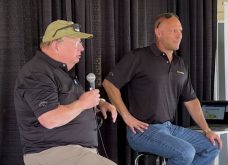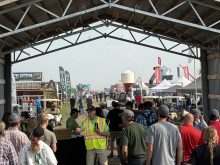Fed price falls
Fed cattle traded 25-75 cents per hundredweight lower last week, said Canfax.
The market was slow to develop.
By late on Feb. 15, sales were mostly steady with the end of the previous week.
Slightly more than 20,000 head traded, down three percent from the week before.
Some sellers opted to pass on the lower bids while others felt they needed to move cattle.
Alberta prices Feb. 16 were steers $88-$88.20 per cwt., flat rail $146.50 and heifers $86-$88.40, flat rail $146.50.
Read Also

One Beer Market Updates Day 3 – Lentils and beef
Day 3 of the One Beer Market Update at Ag in Motion 2025.
Alberta’s two big plants were closed Feb. 20 for the provincial holiday.
Canfax said cattle supplies are not burdensome, but by reducing kills, packers have been able to lower bids.
The Canadian market was watching the U.S. standoff between buyers and sellers, waiting for direction.
Two weeks ago 16,400 fed cattle moved south helping to reduce the supply of market-ready animals.
Carcasses are getting heavier. Steers are 25 pounds heavier than the same week a year ago, while heifers are 29 lb. heavier.
Beef dips again
Canadian cutouts fell $3 two weeks ago to $172 on AAA and $164 on AA.
Canadian beef prices have declined three percent in the past three weeks.
United States prices last week jumped in reaction to reduced beef production after packers cut kills.
The Choice rose nearly $5 US per cwt. and the Select climbed almost $4.
Packers say beef movement is slow and the supply of some product lines is building.
Calgary wholesale prices for delivery this week are $151-$154, $2-$3 higher than the week before.
Feeders weaken
Feeder cattle prices on average fell after some stability early in the week.
Average prices for cattle heavier than 700 lb. fell $2-$3 per cwt. Cattle 700 lb. and lighter saw prices steady to $3.50 lower.
The number of heavier feeder cattle offered fell by 30 percent, as sellers have been put off by recent lower prices, said Canfax.
Compared to a year ago, volume traded was down 18 percent.
Buyer interest was reported as thinner overall. The standoff in the U.S. fed cattle market has many feedlot buyers taking a wait-and-see attitude.
The struggling fed cattle market and the discounted summer futures prices are weakening the heavy feeder market.
But grass-type cattle are trading in their own arena with active interest expected to continue into spring.
Stock bred cows were mostly steady at $900-$1,275 with plainer types at $450-$800.
Bred heifers were mostly $800-$1,250 with plainer types at $550-$750.
A few cow-calf pairs brought $700-$1,175.
On feed
Canfax said the number of cattle in Alberta and Saskatchewan feedlots on Feb. 1 was up three percent over last year.
Placements in January were down nine percent from January 2005.
However, about 28,800 head of western feeder cattle were exported to the U.S. in January 2006, which was not an option last year. When the exports are added to the January placements, it means the number of feeders available to be placed was larger than the 2005 supply.
Hog prices rise
Market-ready hog supplies tightened in the U.S. last week, forcing packers to bid hog prices higher.
Packer margins were on either side of the breakeven point. The composite pork carcass cut-out value rose to $62.87 US Feb. 17, up from $59.27 Feb. 10.
The Iowa-southern Minnesota live cash price for hogs delivered to plants firmed to $44 per cwt. Feb. 17, up from $42.50 Feb. 10.
Federal slaughter in the U.S. was estimated at 1.97 million, down from 2.01 million the week before. Year to date, U.S. hog slaughter is down 0.2 percent.
Traders are wondering what impact recent cases of avian flu will have on pork markets. Worries over the disease have reduced American poultry exports, adding competition in the domestic market. However, foreign consumers might buy more pork to replace poultry and that could increase North American pork exports.
Sheep steady to stronger
At Beaver Hill Auction in Tofield, Alta., 301 head sold Feb. 16. All classes of sheep sold steady to higher.
Lambs lighter than 70 lb. were $140-$157 Cdn. per cwt., 70 to 85 lb. $145-$153.50, 86 to 105 lb. $125.50-$139.50, 105 lb. and heavier $122-$136. Replacement ewes were $70-$76 per cwt., rams were $57-$94 per cwt. and cull ewes were $53-$72 per cwt.
No goats traded.
Ontario Stockyards Inc. reported 1,017 sheep and lambs and 46 goats traded. Sheep and lambs traded $2-$5 cwt. higher. Goats sold steady.
















